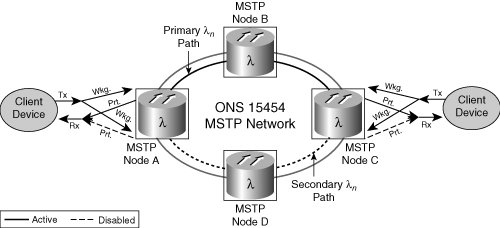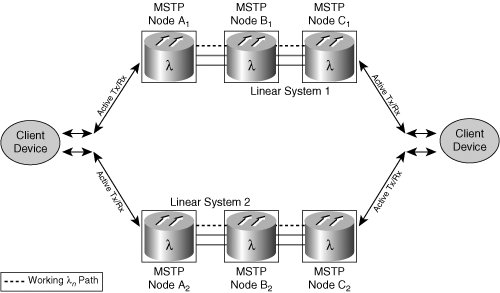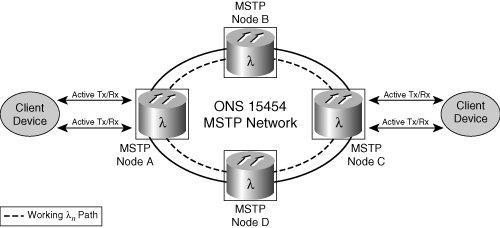Wavelength Services Protection Options
| Typical DWDM systems are deployed in a point-to-point topology with no means of protecting the DWDM trunks themselves, aside from duplicating the channel transmission in a diverse physical path. The ONS 15454 MSTP allows for this type of traditional DWDM channel protection, but also provides more intelligent approaches to DWDM failover that transform the DWDM system into a more SONET-like deployment. For the ONS 15454 MSTP, client interface transponders for wavelength services can be protected using one of three methods:
Y-Cable ProtectionWith this protection scheme, a single-client DWDM wavelength input channel is passively split into two discreet input signals through the Y-cable. The cable is constructed with one client-input port, which is connected to the client device, and two output ports, which are connected to the ports of the ONS 15454 MSTP transponders. Consequently, two transponder/muxponder interfaces are required on the ONS 15454 MSTP shelf assembly to protect against interface card failure. Only one of the two transponder cards can transmit back to the client device at any given time; thus, the transponder/muxponder interface cards are designated as either "working" or "protect." Optical transmissions from the protect interface card back to the client device are disabled, to avoid transmissions error from combining the two transponder/muxponder signals into the Y-cable. Each of the DWDM trunk wavelengths associated with each transponder/muxponder interface is diversely routed in an ONS 15454 MSTP DWDM ring topology to provide network-level protection. Where linear systems are deployed, a single fiber-span failure results in network outages. Figure 11-1 illustrates the Y-cable protection scheme for a ring-based ONS 15454 MSTP topology. Y-cable protection is available only when the unprotected transponder/muxponder interface cards are used in the ONS 15454 shelf assembly. Figure 11-1. Y-Cable Protection Example Dual-Transponder ProtectionSimilar to the Y-cable protection scheme, this protection methodology employs a set of two transponder/muxponder interface cards in the ONS 15454 MSTP shelf assembly. However, the transponder/muxponders operate independently of one another instead of as a protection group, as in the Y-cable example. Because two active signals are present between the client device and ONS 15454 transponder/muxponder at all times, the client device must manage the reception of two active wavelength signals. This can be accomplished using 1+1 automatic protection switching (APS), SONET/SDH ring protocols, or channel load balancing for data devices. Dual-transponder interface protection can be combined with linear or ring network-level protection to provide additional DWDM system resiliency. Where linear systems are deployed, a single fiber-span failure can result in network outages; however, because the dual interfaces operate independently of one another, each transponder/muxponder can be installed in diverse linear systems to mitigate span-failure limitations. The DWDM trunk wavelengths used for protection might or might not use the same channel frequency. Figure 11-2 illustrates the dual-transponder protection scheme for a linear-based ONS 15454 MSTP topology. Combined dual transponder/DWDM ring protection is illustrated in Figure 11-3. Dual-transponder protection is available only when the unprotected transponder/muxponder interface cards are used in the ONS 15454 shelf assembly. Figure 11-2. Dual-Transponder/Linear Topology Protection Options Figure 11-3. Dual-Transponder/DWDM Ring Topology Protection Options DWDM Trunk Split-RoutingThe 2.5-Gbps transponder interfaces for the ONS 15454 MSTP allow for both unprotected and protected DWDM trunk operation. For protected trunk operation, the transponder uses an on-board optical splitter to separate the incoming client signal into two identical DWDM wavelength channels. Both channels traverse the ONS 15454 DWDM network in opposite directions. At the receiving DWDM trunk interface, the transponder uses an optical switch to choose the better-quality signal from the two input paths, based upon performance-monitoring measurements (loss of signal [LOS], loss of frame [LOF], single failure [SF], and signal degrade [SD]). The better of the two signal paths is then transmitted out the transponder client port to interface with an external device. This operation facilitates rapid failure recovery in case of a fiber-span failure. However, because the optical splitting/selection is performed in a single transponder card, this protection mechanism does not allow for interface card protection. Figure 11-4 illustrates the DWDM trunk split-routing protection scheme for a ring-based ONS 15454 MSTP topology. Figure 11-4. DWDM Trunk Split-Routing Topology |
EAN: 2147483647
Pages: 140